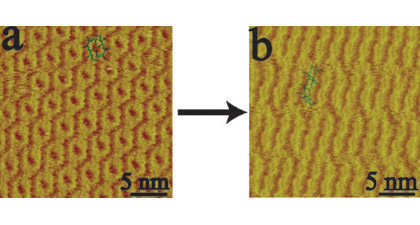Thiophene derivatives are promising materials in electronic and optical devices because of their excellent properties. The behaviors of a molecular assembly are governed by the properties of individual molecules and by their spatial arrangements in the assembly. Understanding the molecular arrangement on a substrate surface is therefore important for constructing oligothiophene-based molecular devices.
With the supports of National Natural Science Foundation, Department of Science and Technology and Chinese Academy of Science, Prof. Li-Jun Wan’s group investigated the formation and transformation of dualoligothiophenes self-organizations on graphite and gold surface. Parts of results were published on Proc. Natl . Acad. Sci. USA (2007,104,3707–3712).
Two kinds dualoligothiophenes, 4T-tm-8T (4T quarterthiophene; tm: trimethylene; 8T: octithiophene) and 4T-tm-4T, were deposited on graphite and gold surface and their assembling adlayer were researched by scanning tunneling microscopy (STM). For 4T-tm-8T, quasi-hexagonal and linear adlayers are observed on graphite at ambient temperature, as shown by Figure a and b. The distinct feature in Figure a is the bright elliptical rings with dark depressions in the center, forming an adlayer structure in quasi-hexagonal symmetry. Each elliptical ring is composed of two 4T-tm-8T molecules, which bend and pair with each other to form the special ring morphology as schematically illustrated in Fig. a. After annealing, only linear adlayer is seen, which indicates that thermal annealing induced a phase transformation from quasi-hexagonal to linear in 4T-tm-8T adlayer. 4T-tm-4T formed wave-like adlayer on graphite in the most of times. The molecules adsorbed on Au(111) surface in randomly folded and linear conformation. The diverse conformation and adsorbing fashions lead to the formation of different adlayer.
After published, the results are paid special attentions by other groups, which are reported by Materialstoday (2007,10(4), 13) and cited by ACS webs as Heat Cut news (March 26, 2007).
Proc. Natl . Acad. Sci. USA (2007,104,3707–3712).

, |
